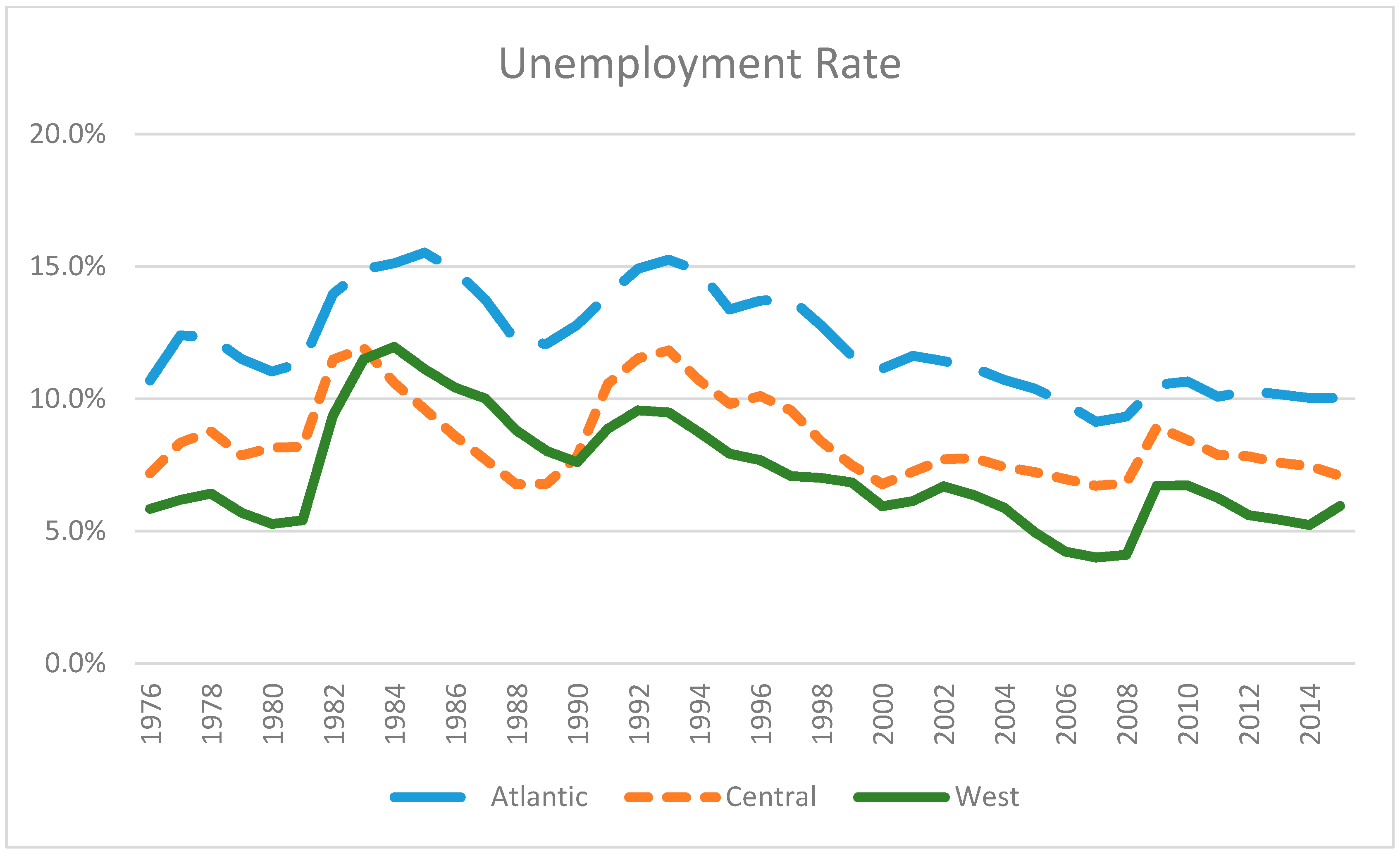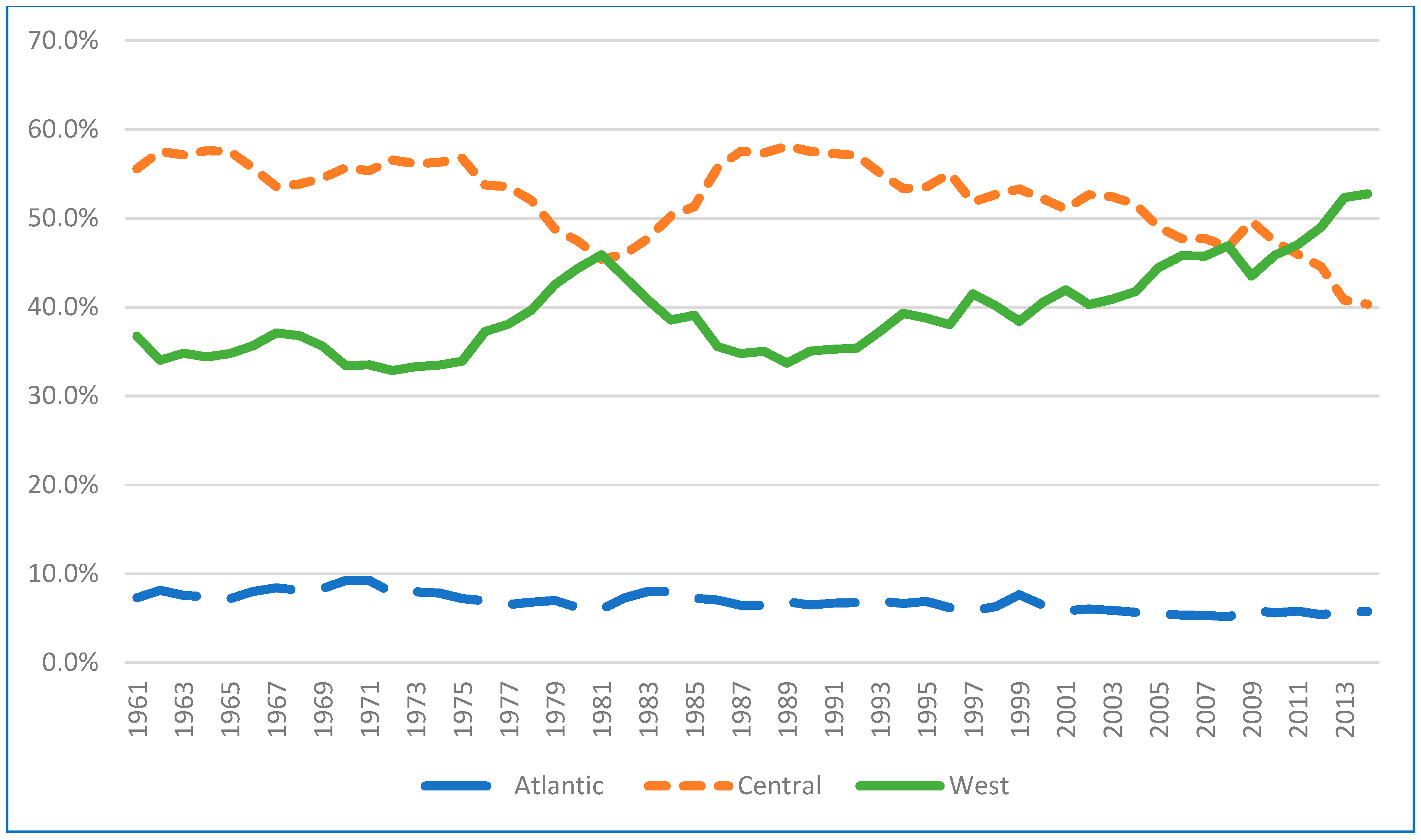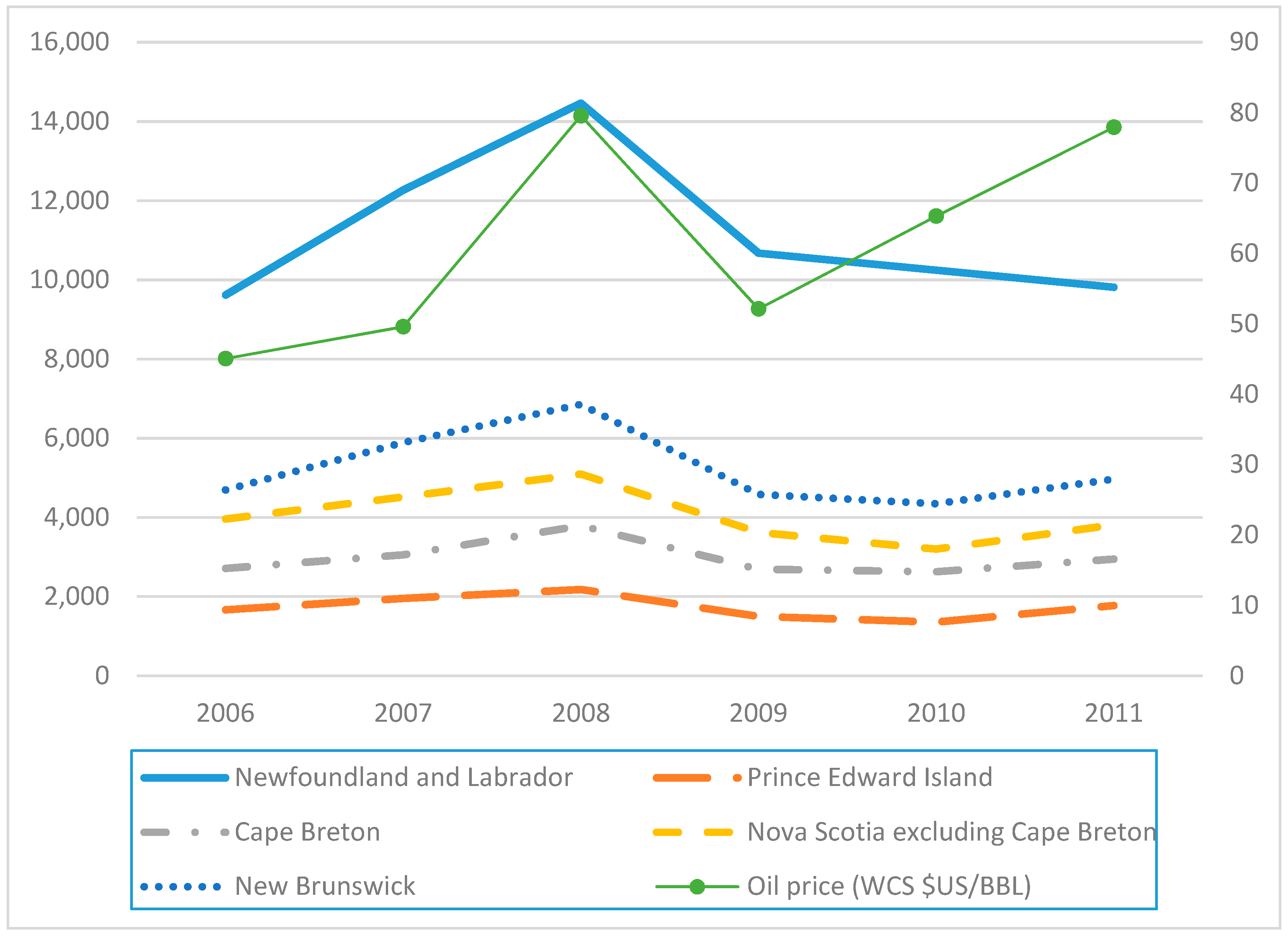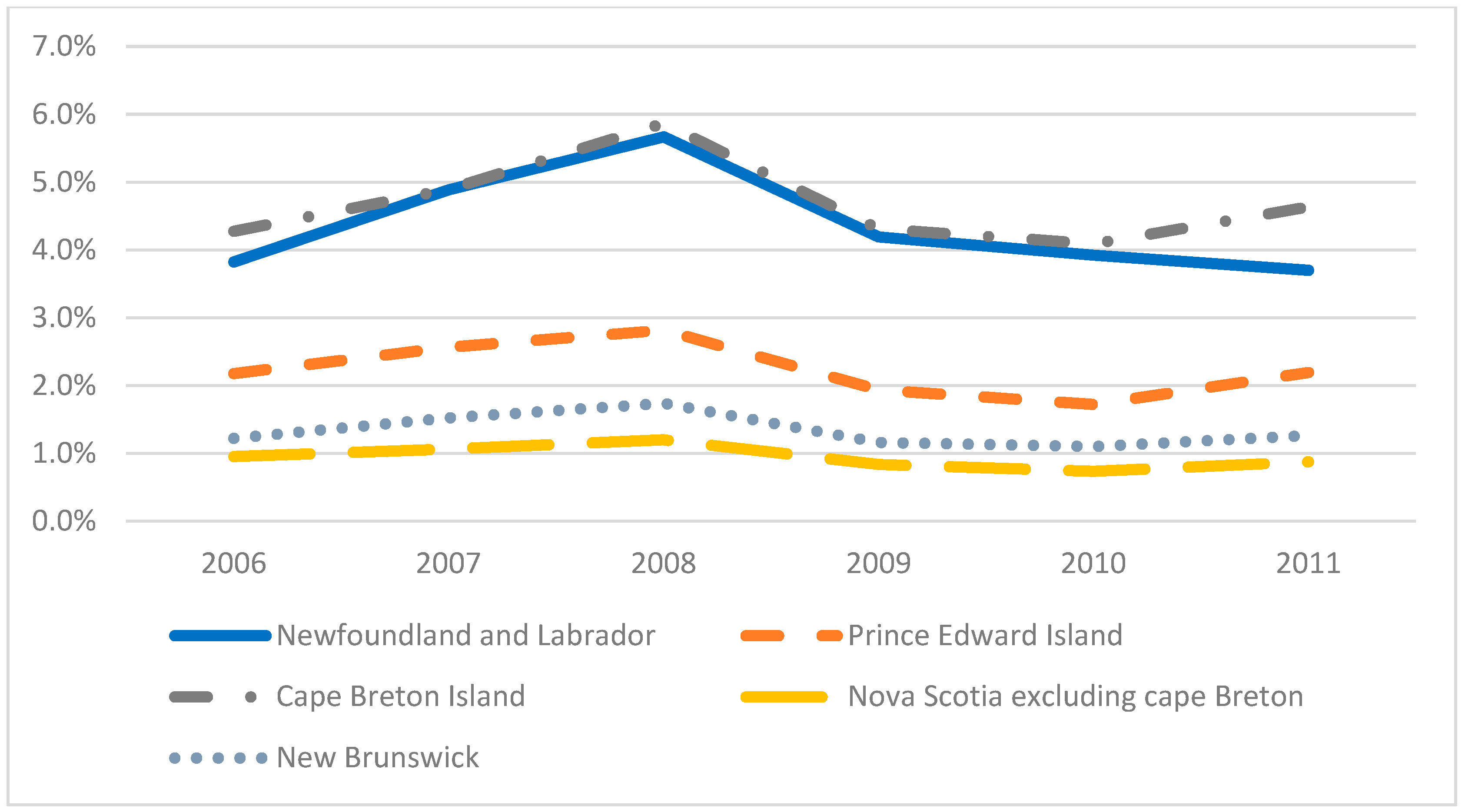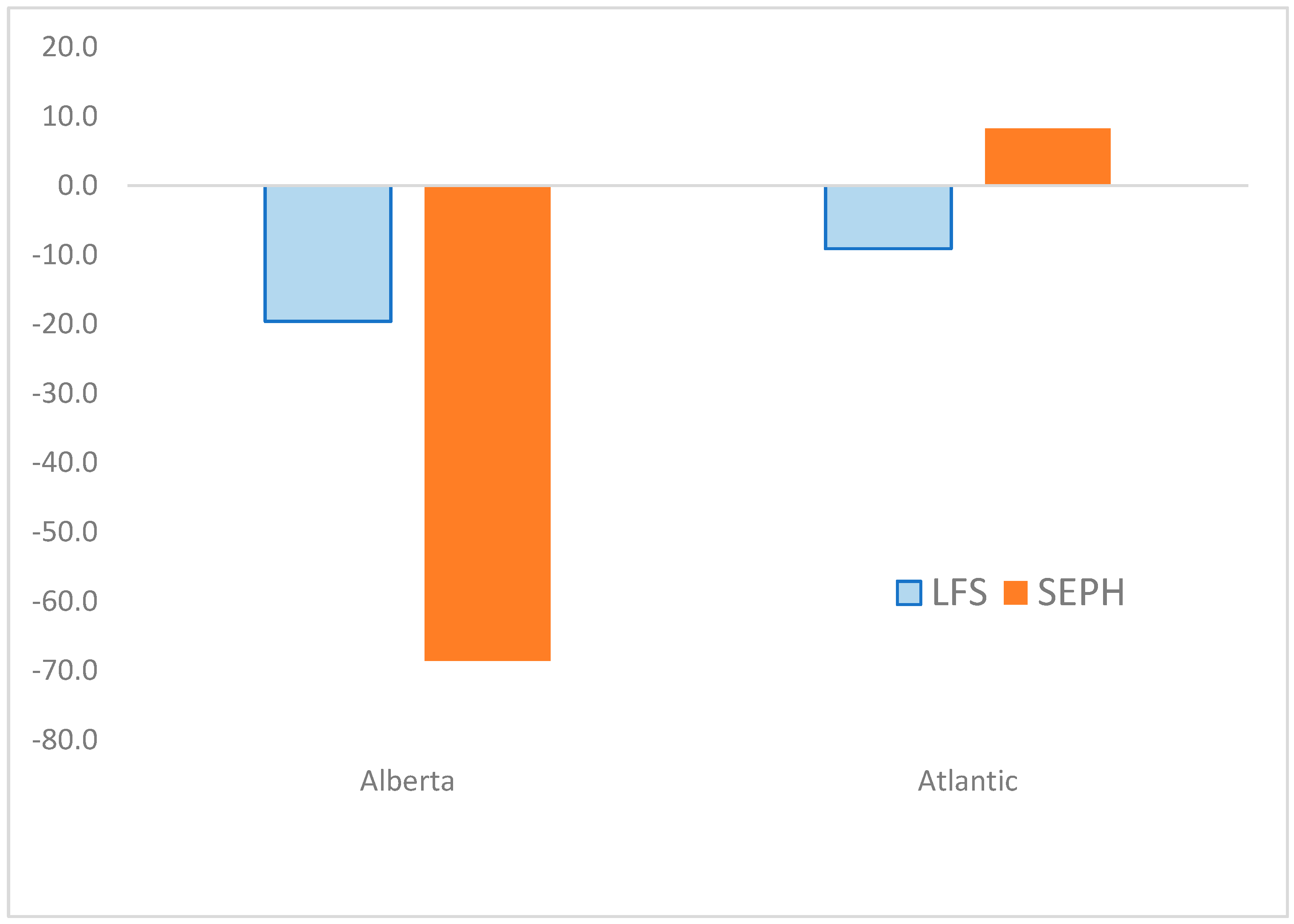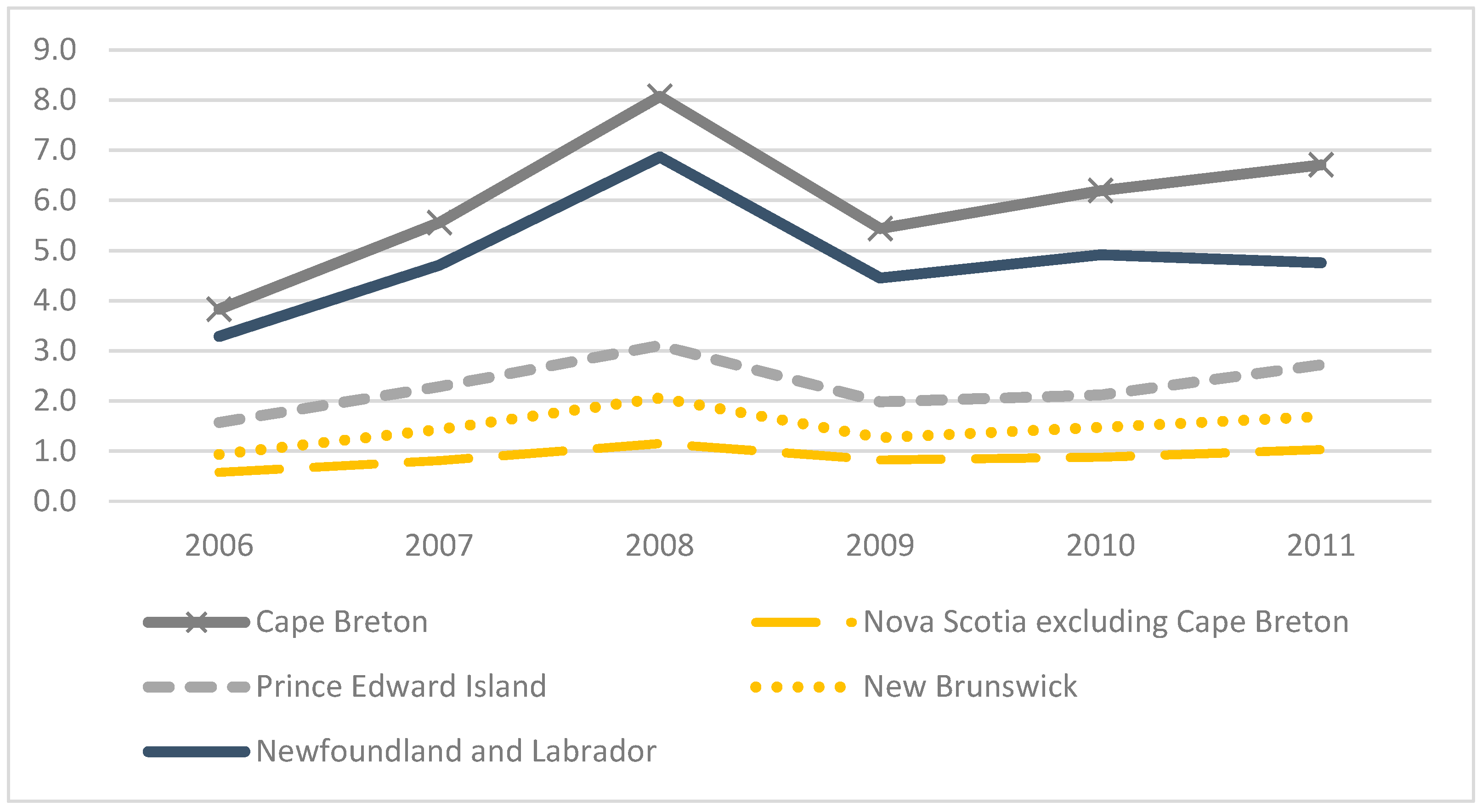3.1. Mobile Workers across Provincial Boundaries
Canadian labour markets have long demonstrated macro-regional unevenness (see
Figure 1). While, Central Canada (Quebec and Ontario) was the engine of the Canadian economy for much of the 20th century, from the 1990s onward, labour markets have been stronger in the West (British Columbia, Alberta, Saskatchewan and Manitoba). The Atlantic Provinces, by contrast, have had chronically weak economies and labour markets for at least 40 years.
Uneven development within Canada reflected in regional variations in labour and capital, marks different eras of investment and dis-investment across the regions. During the 19th Century, Atlantic Canada was the heart of the Canadian economy due to traditional industries such as forestry, fishing, coal, and steel. Post-confederation, however, saw many of the assets of Atlantic Canada stripped and shifted to central Canada. For instance, the major banking head offices were moved to Montreal (Royal Bank in 1907) and Toronto (Bank of Nova Scotia 1900) [
9]. Though the economy of Atlantic Canada was buoyed by the two World Wars, coal mining, steel, fisheries, and forestry all declined in the later half of the century culminating in mine and mill closures and the cod fishery moratorium at the end of the century. For much of the 20th Century, the economic engine of Canada was situated in Central Canada. By the 1970s and 1980s, however, capital investment in the extraction of Western resources began to increase. Since this time, there has been a shift in investment from Central Canada to Western Canada (see
Figure 2, see also [
10]). Indeed, by the late 2000s, Western Canada was attracting the majority share of capital investments in Canada. By contrast, in Atlantic Canada, capital investment has been largely stagnant, or even declining, as new investments in capital stock has barely kept up with the depreciation of existing physical capital.
Mobile capital in search of new locations for profitable accumulation causes severe consequences for those regions left behind. For example, disinvestment in the Atlantic Provinces has led to a host of economic and social problems such as unemployment, poverty, and physical and mental health issues. This is due to the relative immobility of labour versus capital [
11,
12]. People are attached to their home communities as places invested with cultural identity and social meaning [
13]. Therefore, labour tends to be less mobile than capital because its places are important spaces of social and cultural meaning, rather than objective locations of profitable utility (or not). People tend to remain in their communities, despite temporary hardship, particularly if the home community provides a strong sense of identity.
Labour market forces and policy, however, do incentivise people to migrate to spaces where employment is required. As Mazer [
14] argues, labour can be, and has been, made mobile via host of welfare policies to serve extractive industries. This can be witnessed through the flow of migrants from Atlantic Canada first to Central and now to Western Canada. Over the last 20 years, since growth in the Alberta oil sands began, over 200,000 Atlantic Canadians have migrated to Alberta [
1].
Despite interprovincial migration patterns, many communities in Atlantic Canada persevere in the face of economic depletion. Such depleted communities maintain their populations despite the economic challenges [
15,
16]. For a variety of reasons, residents of depleted communities stay in place despite the lack of employment opportunities. Though there may be non-economic factors that enable residents to make-do [
17], there would be strong pressures on families to bring in cash earnings.
Mobile work provides a (partial) solution to workers in depleted communities who wish to remain in place but who are also seeking employment. Mobile work addresses the uneven labour market issue while allowing labour to remain in their community. Mobile work, or employment-related geographical mobility, is defined as employment where labour works in one location but maintains a residence in another, distant, location [
18,
19,
20]. In the extractive sectors, mobile work tends to operate on a rotational schedule where labour would fly or drive in for a period of work time and then return to their home community for periods of rest [
18,
21]. Such forms of mobile work in the Canadian extractive sector have grown due to the growth of extractive industries and the shift to a no-town model of resource development in those industries. [
18].
The no-town model of resource development, however, left industry with a problem of where to source the mobile and flexible forms of labour they required. The solution was found in communities that have suffered from industrial decline or resource depletion where there were adequate sources of appropriately skilled idle labour. Such sources were found in numerous geographies such as former mill towns in British Columbia [
22] and in Atlantic Canada [
23]. As such communities became sources for the labour demand of the oil fields, their internal economies often became de facto single industry towns; a process which Storey and Hall [
23] have termed ‘dependence at a distance’. Where there were critical masses of mobile workers in communities, their local economies became dependent on the work in far away industrial locations. The relationship between such source and host communities brings in mixed impacts for the local community. Positive economic and employment outcomes in source communities are counterbalanced by familial, social and health impacts [
9,
22].
While there has been some research on the impacts of mobile work on workers and their families [
5,
6,
21,
22,
24,
25,
26,
27,
28,
29], there has been little quantitative evidence on the phenomenon. This paper seeks to address this gap. Data from Statistics Canada’s Canadian Employer–Employee Dynamics Database (CEEDD) allow us to address this gap in knowledge.
Based on CEEDD data, we know that mobile work, in the form of interprovincial employment, has been on the rise in Canada. Interprovincial employment refers to workers who maintain residences in one province but work in another, and accounted for 3% of the Canadian workforce in 2011 [
8]. Mobile work is historically linked to extractive industries, especially oil and gas, where production sites were located away from population centres [
21]. Offshore oil and gas operators necessarily used mobile work to staff platforms. In Canada, mobile work is also linked to the oil and gas sector, as increases and decreases in the number of interprovincial workers matches the rising and falling of crude oil prices (see
Figure 3) [
8]. Since the early 2000s, this type of mobile work structure has allowed many from Atlantic Canada to participate in the strong labour markets, driven by oil and gas extraction, in the West, while continuing to remain rooted in their home communities. The next section will provide an overview of the data on mobile workers from Atlantic Canada to Alberta.
3.2. Atlantic Canada Interprovincial Workers in Alberta
Mobile work to Alberta is a significant and growing employment source for workers across Atlantic Canada. Flows of mobile workers from Atlantic Canada to Alberta match the shifts in the regional and global economy. The CEEDD data show that flows to Alberta from Atlantic Canada grew from 2006 until the financial collapse of 2008 when they peaked at 32,377. After the initial crisis was over, flows of workers began to rebound in 2011 when the number of mobile workers stood at 23,309. This rebound flow of workers matched the rebound in oil prices (see
Figure 3). While, at the time of writing, the data are not available for subsequent years, based on both production and construction growth in the Alberta oil sands, we would expect the recovery to continue until 2014. For instance, the Regional Municipality of Wood Buffalo, Alberta tracks its ‘shadow population’ (residents who live in camp accommodations or other forms of temporary housing).
Table 1 shows the growth of this mobile workforce peaking in 2008, and then again in 2014 (at close to double the 2008 population). However, in 2011 Atlantic Canadian IPEs working in Alberta were still at 62%–71% of 2008 levels.
There are some interesting differences at the provincial and sub-provincial level within Atlantic Canada (see
Figure 3). In gross numbers, Newfoundland and Labrador is by far the largest sender of mobile workers to Alberta, accounting for over 40% of Atlantic Canadian mobile workers in Alberta. However, where all other provinces and regions experienced some recovery in the flows of mobile workers to Alberta in 2011, Newfoundland and Labrador numbers continued to decline. This difference is likely due to the greater availability of jobs in Newfoundland and Labrador at that time, resulting in fewer workers deciding to leave their home province for employment in Alberta once the economic recovery began.
While gross numbers of interprovincial workers demonstrate a significant trend in Atlantic Canada, looking at mobile workers as a percentage of employed labour force demonstrates the relative importance of interprovincial work for each region. In this view, Cape Breton and Newfoundland and Labrador saw the highest percentage of their employed labour force traveling to Alberta for work, peaking in 2008 at 6.7% and 6.5% respectively (see
Figure 4). They experienced a very similar trend until 2011, when Cape Breton workers returned to Alberta, while the number of Newfoundland and Labrador workers continued to decline. In 2011, Cape Breton mobile workers in Alberta represented 5.5% of the employed labour force of the region compared to 4.2% in Newfoundland and Labrador. Mainland Nova Scotia’s proportion, by comparison, was 1.0% in 2011. Cape Breton makes up only approximately 15% of Nova Scotia’s population; however, over this five-year period, 41%–45% of Nova Scotia’s total IPEs who worked in Alberta came from Cape Breton. This demonstrates the degree to which mobile work in Nova Scotia is concentrated in Cape Breton.
While not having the same levels as Cape Breton and Newfoundland and Labrador, the data also demonstrate that there is a higher concentration of mobile workers in PEI, at 2.5% of employed labour force, compared to mainland Atlantic Canada with 1.0% in mainland Nova Scotia and 1.4% in New Brunswick. The reliance on work in Alberta seems to have the largest impact in regions with smaller and more isolated populations in Atlantic Canada.
3.3. Reliance on Alberta for Work among Interprovincial Workers
Despite the decrease in numbers of employees travelling to Alberta for work after the 2008 financial crisis, those who do continue to travel to the province for employment rely on that work for increasing portions of their earnings.
Figure 5 shows the percentage of IPEs earning 75% or more of their T4 earnings in Alberta. The trend shows that interprovincial workers in all provinces of Atlantic Canada are using employment in Alberta to generate a greater portion of their total income. By 2011, 75% of IPEs from Newfoundland and Labrador and 74% from Cape Breton earned 75%–100% of their total T4 income from Alberta. Comparatively, only 58% of IPEs from PEI, 59% from mainland Nova Scotia, and 67% from New Brunswick earned 75%–100% of their total T4 income from Alberta.
However, within this five-year span, IPEs from the Atlantic Provinces all increased their reliance on Alberta, with an average increase of employees who earn 75% or more of their earnings in Alberta by 12%. The highest increases came from PEI and New Brunswick, regions with previously lower levels.
Despite this overall increase in the intensity of work in Alberta across Atlantic Canada, interprovincial employees in Newfoundland and Labrador and Cape Breton are using work in Alberta as a significant portion of their income to a greater extent than other regions. Workers from PEI, mainland Nova Scotia, and New Brunswick may be more likely to only work in Alberta as a way to supplement seasonal employment from their home province or engage in mobile work to other provinces. Nevertheless, due to the increased reliance on Albertan income as a larger percentage of IPE’s total income, even in regions like PEI where seasonal offsetting is more likely to occur, the shift to rely on Albertan IPE employment as primary income can be observed.
3.4. Individual Earnings
As a consequence of mobile workers relying on work in Alberta for greater portions of their incomes, they are bringing home increasing amounts from that employment.
Table 2 shows the median earnings from mobile workers that were earned in Alberta. All provinces saw their IPE median earnings from Alberta grow from 2009 to 2011. Interprovincial employees from Cape Breton earned a median income of
$24,140 from Alberta in 2009, which rose to
$31,571 by 2011. In the rest of Nova Scotia, IPEs only earned
$15,278 median income from Alberta in 2009, but still saw a substantial rise to
$21,448 in 2011. In Newfoundland and Labrador, IPEs earned a median income of
$24,479 in 2009 and had a dramatic increase of almost
$12,000 to reach a median income of
$36,258 in 2011. In PEI, in 2009, the median earnings for all IPEs working in Alberta were
$16,544, rising to
$21,488 just two years later. New Brunswick, unlike previous trends, falls more closely in line with Newfoundland and Labrador and Cape Breton when analyzing median earned income. In 2009, median earned income was
$23,071 and by 2011 had jumped to
$31,787. It is important to note that the median earnings reported were not the total individual annual income, just the portion that was earned in Alberta.
3.5. The Role of the Oil and Gas Sector
Interprovincial employment in Canada is intricately tied to the price of oil. From 2002 to 2011, the trends of interprovincial employees in Canada matched the rise and fall of the price of oil ref. [
8]. From 2006 to 2011, employers in Alberta were able to pay workers substantial compensation because this work was tied to the high price of oil. This created a situation where employers from Alberta paid significantly higher wages and provided perks to employees that could not be matched by home employers. In 2011, out of all the IPEs in Alberta from the Atlantic Provinces, the highest numbers were working in industries that relate to construction and oil and gas extraction and support activities. Out of the 9813 IPEs in Alberta from Newfoundland and Labrador, 16% worked in oil and gas extraction and support activities, and 44% worked in the construction sector. In Cape Breton, very similar percentages are found. Of these Cape Breton IPEs, 17% worked in oil and gas extraction and support activities, and 46% worked within the construction sector.
This may have negative implications in Cape Breton and Newfoundland and Labrador, as workers in the construction sector find themselves in a more precarious position than their oil and gas extraction colleagues. They rely heavily on new investment in the Fort McMurray area and are more likely to be at risk of losing their jobs when downturns occur. It is estimated that oil price declines will cause a decline in investment in oil sands projects by 66% from 2015 to 2019 [
31]. From 2015 to 2020, oil sands production, on the other hand, is expected to grow by 34% [
32]. These forecasts reflect the reality that workers have faced during the recent downturn, and help to demonstrate where demand for workers has continued and where it has dropped off significantly within the oil sands region. Following a 25-year peak in construction job growth in 2014, it is anticipated that Alberta will lose another 31,000 construction sector jobs by the end of 2019. The bulk of these job losses will be felt by IPEs, many of whom are from Atlantic Canada [
31]. This effect can be seen in the contrasting trends in labour force data versus employer data in Alberta and the Atlantic Provinces. Labour force data come from the labour force survey, a household survey which would record labour in their place of residence. Employer data come from Survey of Employment, Payrolls and Hours (SEPH) which records employment at the place of work.
Figure 6 shows that Alberta employers had shed 68,600 jobs in 2015 (looking at SEPH), but Alberta employment decreased only by 19,600 jobs. In contrast, the Atlantic Provinces saw a net gain of 8200 jobs from Atlantic Canadian employers, yet the number of employed persons declined by 9100 in the same period.
In New Brunswick and PEI, we see a different industrial sector break down of mobile workers. Out of the 4966 IPEs from New Brunswick, there is a similar concentration in oil and gas extraction activities (15%); however, only 28% within the construction sector. In PEI, interestingly, there was a much higher percentage of workers in oil and gas extraction and support activities (31%), and a disproportionately high percentage (14%) of workers in the professional, scientific, and technical sectors compared to any other province in Atlantic Canada (6.5%–8%). PEI, additionally, only saw 19% of its IPEs in Alberta working within the construction sector.
3.6. Regional Income Flows
Employment income from Alberta contributes significantly to the overall Atlantic Canada economy.
Table 3 shows the total employment income by region from interprovincial earnings. Overall, income earned by interprovincial employees added 2.3 billion dollars to the Atlantic Canadian economy in 2011. Out of this total income, income from Alberta-destined mobile workers contributed 1 billion dollars (the other main sources were neighboring provinces within Atlantic Canada (
$428M and Ontario (
$400M). In the island economies of Cape Breton and Newfoundland and Labrador, the hundreds of millions of dollars earned by IPEs annually primarily came from Alberta (64.8% and 57.2% respectively). In the rest of Nova Scotia and New Brunswick, while still seeing more than half a billion dollars inflow into their economy from interprovincial employment, less of this income came from Alberta (29.1% and 37.4%). PEI earned 45% of interprovincial employment income from Alberta.
The total amount of income generated from this type of employment demonstrates the significance of flows coming in from interprovincial employment to Alberta. The narrative, however, becomes even more consequential when comparing these figures to the total earnings within these provinces and regions to understand the impact this type of economic inflow is truly having in these locations.
Figure 7 shows the percentage of aggregate wages and salaries coming from interprovincial employment in Alberta.
The Cape Breton region received the largest contribution from mobile work to Alberta at 6.7% of total aggregate wages and salaries in 2011. This is down from a peak of 8.1% in 2008. By contrast, for mainland Nova Scotia, IPE wages and salaries from Alberta only make up 0.9% of the total wages and salaries. This demonstrates that the Cape Breton economy is significantly more dependent on the income from interprovincial employment in Alberta than the rest of Nova Scotia, where interprovincial employment to Alberta remains a minor component of economic activity.
Newfoundland and Labrador also receives an important portion of its total earnings via mobile work in Alberta. In 2011, IPE income from Alberta comprised 4.8% of Newfoundland and Labrador’s employment earnings. Newfoundland and Labrador’s dependence also peaked in 2008 at 6.9%, but has since diverged from the trend in Cape Breton. This demonstrates that Newfoundland and Labrador’s economy is more robust and diversified than the Cape Breton economy (largely due to the oil production in the province itself).
From 2006 to 2011, taking into account fluctuations due to the recession and various factors, the dependence on Albertan IPE wage and salary contributions made up an increasingly larger share of total wages and salaries in all regions of Atlantic Canada. In Cape Breton, this increase was by far the most dramatic with a growth of 2.9% over this time period. However, even in PEI (growth of 0.7%), Nova Scotia excluding Cape Breton (growth of 0.4%), New Brunswick (growth of 0.8%), and Newfoundland and Labrador (growth of 1.5%), the growth trend indicates that all of the economies of the region depended to a larger extent on this distant employment.
While the choice to work in Alberta is an individual one that workers make for reasons that are specific to them and their families, this individual choice, when applied on such a large scale, are having economic impacts across Atlantic Canada. Most significantly, this economic impact is apparent in Cape Breton, PEI, and Newfoundland and Labrador, where mobile work is increasingly becoming an important part of the economy for these island regions. However, even amongst more diverse Atlantic Canadian economic regions, the economic inflows from Alberta-driven interprovincial employment have also increased over this period. Unlike other workforce or economic development strategies, Atlantic governments are not actively shaping or controlling these economic inputs. As such, the individual choices that are made, combined with labour needs across the country, have created large-scale economic realities in these regions.
The data presented above demonstrate that there were large numbers of Atlantic Canadians working in Alberta from 2006 to 2011 and that the majority of these workers were linked to the oil and gas sector. These workers disproportionately came from islands in Atlantic Canada comprised of; Newfoundland, Prince Edward Island and Cape Breton Island, as workers from the various regions use interprovincial employment differently. Nonetheless, interprovincial employees from across Atlantic Canada were increasingly dependent on employment in Alberta as their main source of income.
Interprovincial workers from Atlantic Canada to Alberta are attracted by higher wages and more employment opportunities. This produced a push–pull factor for workers in Atlantic Canada to join the IPE workforce in Alberta. The individual decision to travel to Alberta for work contributed a significant amount of aggregated income to the Atlantic Canadian economy. This was felt most acutely in regions like Newfoundland and Labrador and Cape Breton where income from Albertan IPEs made up a large portion of total economic activity within these regions. The data also presented contribute to a larger narrative of interprovincial employment to Alberta that has circulated throughout Atlantic Canada [
5,
6]. These numbers complement this knowledge by providing data to support what is being felt and experienced as interprovincial employment plays out across Atlantic Canada. It also offers important differences that help to tell unique stories about the impact of interprovincial employment to Alberta across the region.
